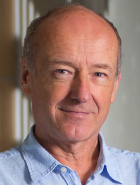Dr. Peter Lansdorp
 Medical Genetics
Medical Genetics
Research Interests
- DNA replication, epigenetics and stem cells
- Telomeres, genomic instability, aging and cancer
- Genetic analysis using single cell Strand-seq
Asymmetric cell divisions are essential for the development of all multicellular organisms. Many mechanisms are known to help secure differences in cell fate between daughter cells following the division of a parental stem cell. We are interested in possibility that programmed epigenetic differences between sister chromatids contribute to gene expression differences during development [1]. Such differences may arise when the deposition of parental nucleosomes onto replicated DNA immediately following replication is asymmetric because the replisome encounters a problem on one of the DNA template strands. Strand-specific DNA replication problems are not theoretical. We showed in 2002 that the replication of guanine-rich DNA requires a specialized helicase, which we called Dog-1 for Deletion of guanine-rich DNA [2]. We subsequently identified RTEL1 in the mouse as a major regulator of telomere length [3]. DOG-1 (aka FANCJ) and RTEL1 are iron-sulfur cluster helicase proteins that can unwind secondary structures of guanine-rich DNA called guanine quadruplex (G4) structures [4]. G4 structures were recently shown to regulate gene expression [5]. The presence and role of G4 structures at specific genomic locations as well as the enzymes required for resolving G4 structures in genome stability, gene expression and differentiation are areas of special interest. For such studies we recently developed techniques to identify and study sister chromatids in single cells [6, 7]. Current studies in the Lansdorp lab focus on three questions that can be answered using our single cell sequencing technique called Strand-seq [8]:
